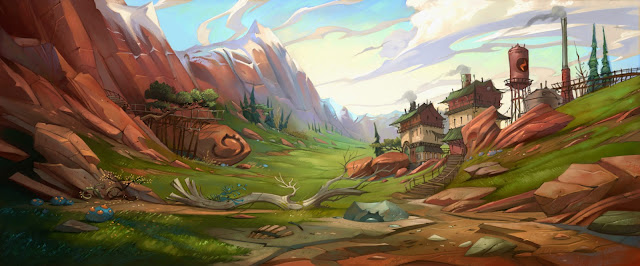Tipzutopia - The mesmerizing worlds of video games come to life through the artistry and ingenuity of game art and design. Behind the captivating virtual landscapes, intricately detailed characters, and immersive gameplay lies the dedicated efforts of talented artists and designers. In this article, we embark on an awe-inspiring journey to explore the dynamic realm of game art and design, delving into its creative processes, challenges, and the indelible impact it leaves on the gaming industry.
1. The Artistic Canvas: From Concept to Creation
At the genesis of game development, artists breathe life into the virtual worlds through concept art. This pivotal stage involves envisioning the visual aesthetics of characters, environments, and key elements. Concept artists work closely with the development team to translate these visions into tangible assets that align with the game's narrative and mechanics.
The creative process then branches into various disciplines, including 2D and 3D artists, animators, and texture artists. Through iterative design and collaboration, these experts meticulously craft characters, animations, and environments. The marriage of artistry with technical prowess ensures a seamless and visually stunning gaming experience for players to immerse themselves in.
2. Navigating the World of Game Design
The realm of game design serves as the blueprint for interactive experiences within virtual worlds. Designers sculpt the gameplay mechanics, level layouts, and puzzles that challenge and engage players. Striking a balance between difficulty and enjoyment is paramount in crafting memorable gaming experiences.
Through extensive playtesting and iterative feedback, designers fine-tune gameplay elements to optimize player satisfaction. The dynamic nature of game design makes it a perpetual journey of experimentation and innovation, where every decision impacts the overall gaming experience.
3. The Magic of Animation: Breathing Life into Characters
Animation infuses characters with life, giving them personality and endearing qualities that resonate with players. Animators meticulously create movements, facial expressions, and combat actions to add emotional depth to storytelling and enhance gameplay immersion.
The advent of advanced motion capture technologies has revolutionized character animation, allowing for more realistic and dynamic movements. Animators skillfully blend artistry with technology, ensuring that characters move fluidly and authentically within the virtual worlds.
4. Building the Worlds: Environmental Design and Immersion
Environmental design forms the foundation of players' adventures, captivating them with breathtaking landscapes and atmospheric settings. Environmental artists work diligently to create visually stunning and architecturally impressive worlds that evoke emotions and transport players to fantastical realms.
The art of immersion extends beyond visual aesthetics, incorporating lighting, color theory, and sound design to enhance the overall gaming experience. As players traverse these meticulously crafted environments, they feel connected to the virtual world and are driven to explore and uncover hidden secrets.
5. Striking Art Styles: From Realism to Stylization
The diverse spectrum of game art styles ranges from photorealism to highly stylized aesthetics. The choice of art style profoundly influences the game's identity, evoking different emotions and leaving a lasting impression on players.
Realism, with its attention to detail and authenticity, creates a sense of believability within the virtual worlds. On the other end of the spectrum, stylized art empowers developers to explore unique and imaginative aesthetics that transcend the boundaries of reality. Each art style contributes to the game's narrative and mechanics, making it an integral aspect of game development.
6. The Power of Conceptual Art and Visual Storytelling
Conceptual art stands as the cornerstone of game development, providing the visionary direction for the entire project. Concept artists adeptly communicate the mood, tone, and atmosphere of the game through visual storytelling.
These visionary artists create breathtaking scenes, iconic characters, and captivating environments that serve as the artistic vision for the entire development team. The fusion of concept art with game design ensures that the final product conveys a coherent and immersive narrative.
7. Beyond Gaming: Art Direction and Transmedia
Game art and design extend beyond the gaming sphere, influencing various transmedia projects. The impact of game art and design resonates in comic books, animated films, merchandise, and even theme park attractions.
This transmedia presence underscores the profound influence of gaming artistry on popular culture. It showcases the versatility of game art and design, proving that these creative endeavors leave an indelible mark in the broader entertainment landscape.
Conclusion:
Game art and design stand as the vanguards of the gaming industry, weaving creativity and craftsmanship into the very fabric of virtual worlds. The dedication and artistic vision of designers, artists, and developers transport players to magical realms, offering unforgettable experiences. As gaming continues to evolve, the seamless fusion of artistry and technology will shape the future of gaming, leaving players in awe of the limitless possibilities that lie ahead. The brilliance of game art and design serves as a testament to the boundless human imagination, fueling the vibrant universes that captivate the hearts of gamers across the globe.



